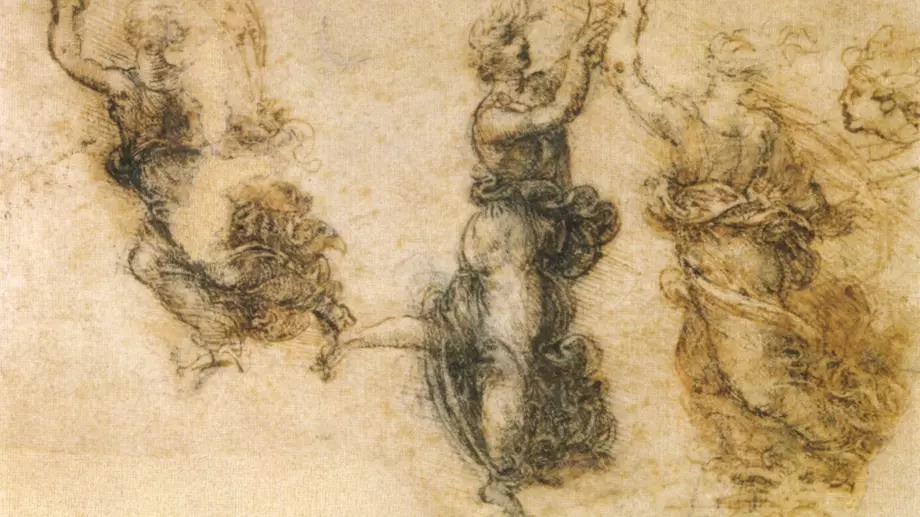
Leonardo's festivities
Leonardo's duties at the Milanese court (1486-1499) and later at the French court (1516-1519) included the organization of elaborate courtly festivities. Leonardo was responsible for the artistic design and created scenery, stage sets and costumes. Since he was a good singer and played numerous instruments, he probably also provided musical accompaniment to the festivities. Because of the unprecedented magic of the staging, the feasts organized by Leonardo left a legendary impression on all the guests. The "Paradise Feast" (Ital. 'Festa del Paradiso') is the most famous feast that Leonardo staged.
La Festa del Paradiso
On January 13, 1490, at the court of Ludovico Sforza, Leonardo staged the "Festa del Paradiso" (Italian for 'Paradise Feast'). The festival became so legendary that Leonardo had to stage it again for the French King Francis I, 25 years later. The occasion for the festival was the marriage between Isabella de Aragón and the underage Gian Galeazzo Sforza, the rightful Duke of Milan, which had taken place a year earlier. Very few details of the festival itself have been recorded.
Sequence of Events
The festival was designed as a grand theatrical production. Guests were led to their seats in a predetermined order. All the servants were dressed as stars. The focal point of the room was a large stage initially concealed behind a satin curtain. At twilight, an angel spoke, and to the sounds of a choir, the curtain fell to reveal Paradise. It was shaped like a halved egg, its interior entirely gilded with numerous lights as stars and some niches containing the seven planets, depending on their rank, either above or below. Along the edge of the upper semicircle, the twelve zodiac signs with enclosed lights were arranged, creating a graceful and beautiful spectacle. In this Paradise, many songs and sweet, gentle melodies could be heard.
The seven planets were personified as gods, standing on a massive machine that moved them like a giant wheel. Jupiter in the center, surrounded by Mercury, Venus, Mars, Saturn, Apollo as the Sun, and Diana as the Moon. The youthful and beautiful performers stood in a semi-open sphere, entirely painted in white and covered with only a few white fabrics. They held a large white wax candle and the respective attribute of the gods they represented. Each time a planet approached the bride Isabella, the corresponding divine being emerged from the sphere and sang the verses composed by the court poet Bellincioni. These verses were divine hymns praising the newlyweds; for instance, Venus praised the beauty of the bride, and Apollo extolled her talents. Graceful graces danced to the verses. Finally, the bride left the festival on a path of candles, which gradually extinguished behind her.
Symbolism
Overall, the stage represented a stylized eye: the outer shape resembled a halved egg, and in the center, there was a giant wheel-like structure. The stage set also depicted seven planets. Seven, because at the time, telescopes had not yet been invented, and celestial bodies could only be observed with the naked eye. Thus, the seven planets corresponded to the celestial bodies visible to the naked eye: Mercury, Venus, Mars, Jupiter, and Saturn. Unlike today, the Sun and the Moon were also considered planets. Uranus and Neptune remained undiscovered at that time.
Baldassore Taccones "Danae"
Baldassore Taccone was chancellor to the Duke of Milan, Ludovico Sforza.Taccone was also active as a writer and wrote "La Danae", a comedy in five acts.The play was performed at the court of Milan in 1496. What is known today about the performance comes from Taccone himself. Also preserved is a sketch by Leonardo of the stage set, which also lists the names of the actors, as well as measurements of their position on the stage. As was customary at the time, Danae was played by a male actor. Taccone himself took on the role of the gardener Sirus.
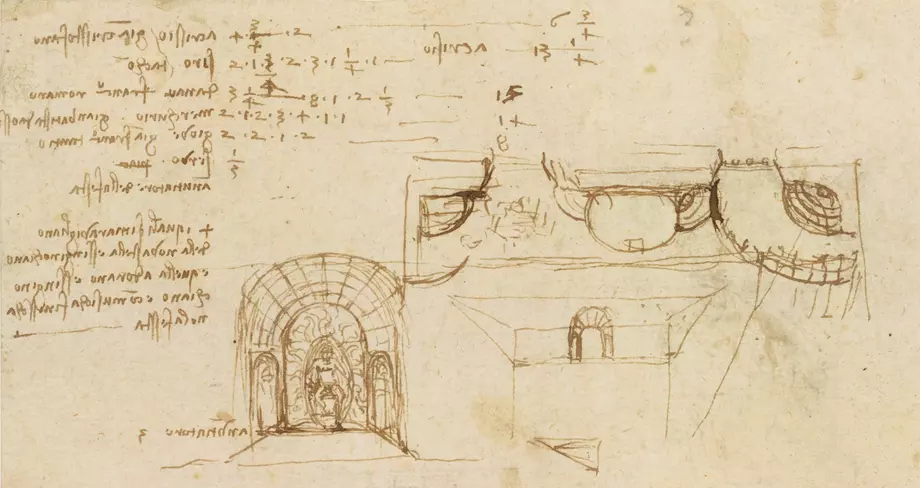
On the upper left, a list of the actors involved and measurements of their positions on the stage.On the right side, sketches of the stage design in elevation (bottom), plan (top), and bird's eye view (far right).
Bottom left, in the center of the stage set, Jupiter, seducer of Danae, on an oval throne and surrounded by a flaming aura.
Who was Danae?
Danae is a character from Greek mythology. She was the daughter of Akrisios, the King of Argos. When an oracle warned him that he would lose his throne and life at the hands of her child, he imprisoned her in a cell guarded by dogs. However, the chief god Zeus desired Danae. He transformed into a golden shower to reach her. Danae's father then cast his pregnant daughter into the open sea, but she was saved by Poseidon, who brought her to the mainland. Danae later gave birth to the Greek hero Perseus, who ultimately fulfilled the prophecy by killing Akrisios.
Taccone's Variation of the Tale
Taccone interprets the ancient myth quite freely. He has the pregnant Danae sentenced to death by her father, after which she is saved by Jupiter, who transforms her into a star and makes her ascend into the sky in an explosion of light and sound. Throughout the play, the character of Mercury spends his time flying between Earth and Olympus.
Stage Design
The rising and descending of the divine messenger Mercury was likely executed using a lifting platform designed by Leonardo da Vinci, similar to what he had constructed for the Paradiso Feast. It is possible that the other actors also stood on individual platforms, allowing them to be separately lifted upwards. This would explain why Leonardo recorded the precise positions of the actors. In essence, lifting platforms were not uncommon but rather a Renaissance trend. The Florentine artist and engineer Filippo Brunelleschi had already employed lifting platforms for theatrical performances at the beginning of the 15th century. What makes Leonardo's lifting platforms special is the complexity of the mechanics and the overall artistic impact.
In addition to the large lifting platform, the stage's roof was impressive. Numerous oil lamps there shone like stars, symbolizing Olympus. Furthermore, the performance was accompanied by musicians hidden behind the stage machinery.
Leonardo's theater machines
Leonardo not only built the already familiar lifting platforms, but combined his mechanical knowledge with his imagination to create previously unknown machines that some now describe as robots. They are among his most famous inventions.
The automobile
Leonardo made a sketch of a carriage reminiscent of a modern automobile. The wheels of this invention were connected with a system of gears and there was a device to brake the vehicle. However, it lacked a driver's seat. For a long time it was unclear how the vehicle was to be powered and what its purpose was. Today, it is generally assumed that it was an oversized wind-up car that was supposed to be driven by a tension spring. To the surprise of the audience, it could therefore drive onto the stage by itself. It is conceivable that actors then stood on the vehicle or that parts of the stage set drove into the scene in this way. However, there are no contemporary reports of the automobile actually being used.
The mechanical lion
In an early Leonardo biography of 1550, Giorgio Vasari reports:
"At this time the King of France came to Milan, and at his entreaties to make some marvelous thing, he made a lion that could walk a few steps, and now and then opened its breast, which was full of lilies."
Lilies are both the symbol of the French monarchy and the coat of arms of Florence, Leonardo's hometown. The lion is an ambiguous symbol. On the one hand, it represents the majestic power of the king. On the other hand, the lion, in its Latin translation '(Panthera) Leo', can also be understood as a pun on Leonardo. Two sketches of Leonardo in his notebooks speak for the fact that the scene has actually represented itself in such a way, as Vasari reports.
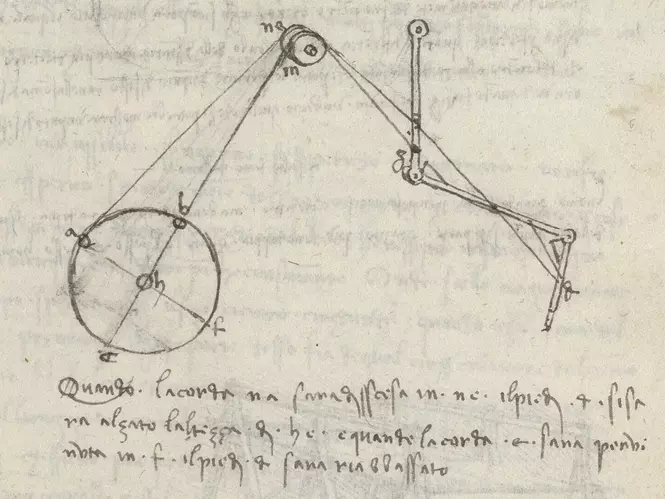
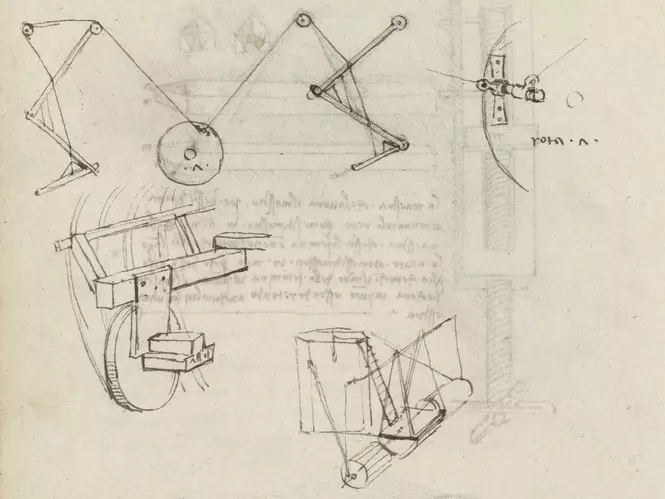
The mechanical knight
In Leonardo's Notzibücher can be found sketches of a mechanical knight. It is unknown whether this was realized. Since the sketches are very detailed and scattered over several notebooks, it can be concluded that it was a project that took some time to complete. The sketches indicate that the knight could move via a system of pulleys, e.g. he could move his arms and tilt his head.
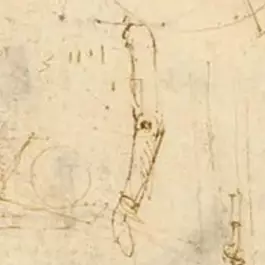
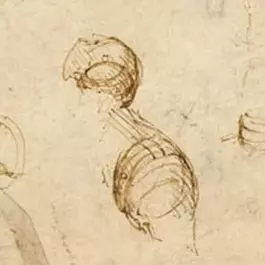
The drawing is on the back of the sheet with the mechanical arm
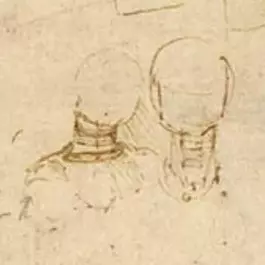

The drawing is in the midst of studies on gears and pulleys
Costume Designer
Leonardo also designed costumes for the festivals he organized. However, only a few drawings of them have survived.
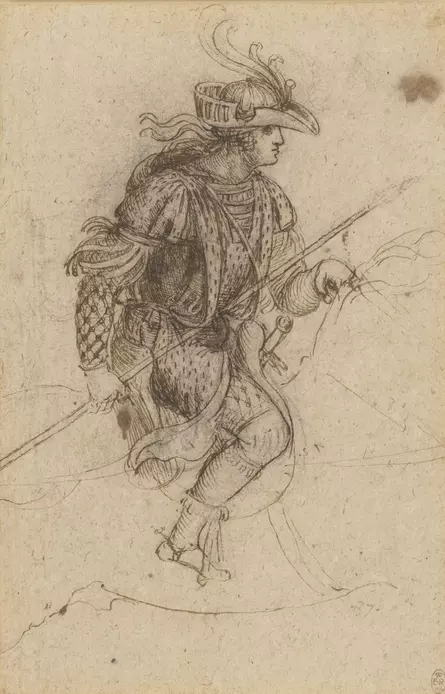
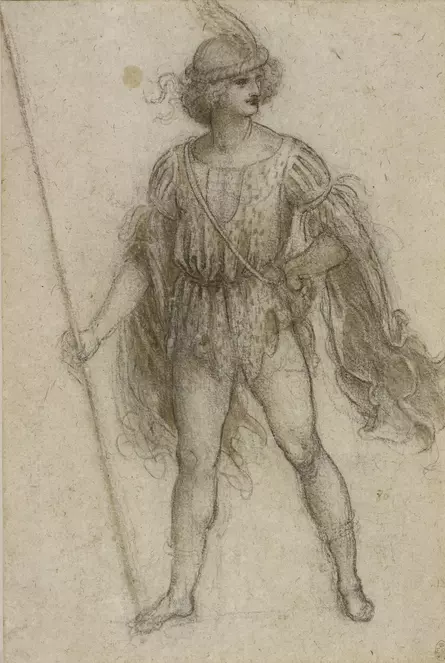
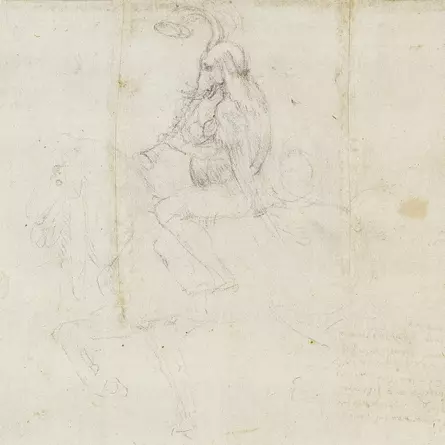
Musician
Leonardo's impressive performance on the lyre is said to have made such an impression during an official visit by a Florentine delegation to Milan that the Milanese ruler Ludovico Sforza invited Leonardo to his court. Giorgio Vasari reports this in his 1550 biography of Leonardo:
"In the year 1494, Gian Galeazzo, the Duke of Milan, had passed away, and Lodovico Sforza was elected as his successor. He took great pleasure in playing the lute, and thus Leonardo was honorably summoned. He brought with him an instrument that he had crafted almost entirely out of silver in the form of a horse's head, a strange and novel shape designed to enhance the sound's strength and beauty. This surpassed all the musicians who had come to Milan to perform. Additionally, he was the best improvisational poet of his time. The Duke, enchanted by Leonardo's extraordinary talents, fell in love with his abilities to an almost unbelievable degree."
However, this is likely a legend. While Leonardo did indeed travel to Milan in 1482 as part of a Florentine delegation and moved to the city in the same year, he only became a member of the Milanese court about four years later. Prior to that, he had spent three years, from 1483 to 1486, working as an independent painter on his first independent painting, the "Madonna of the Rocks," commissioned by Milanese monks. This relatively significant commission was likely the reason for Leonardo's move to Milan.
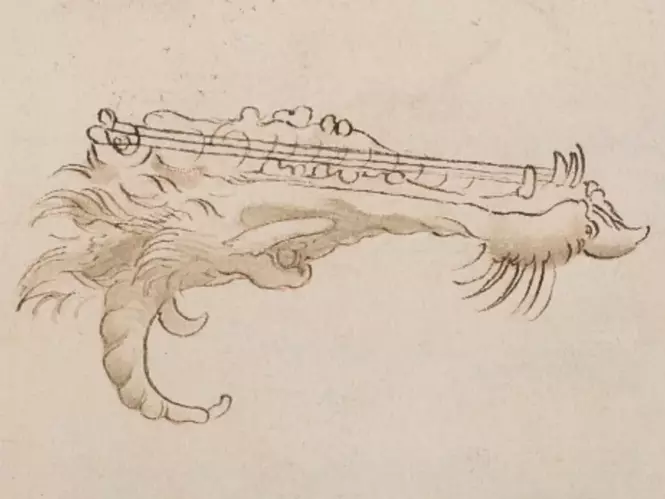
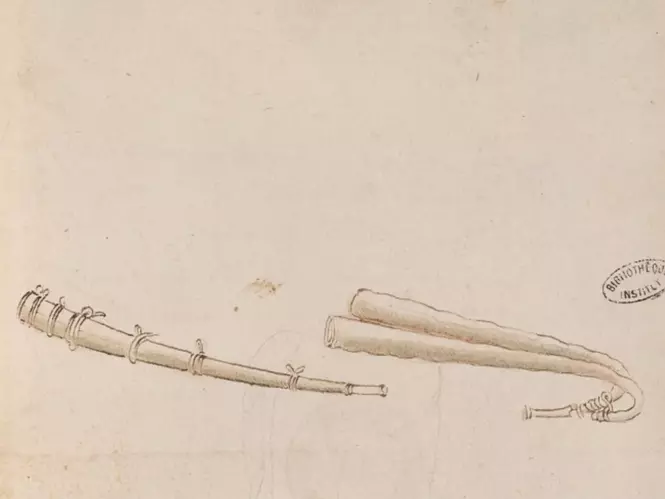
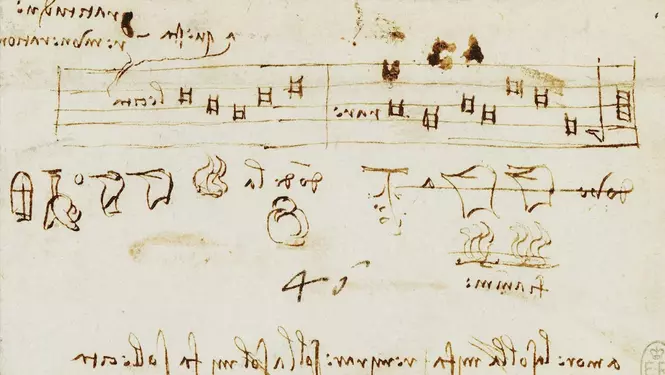
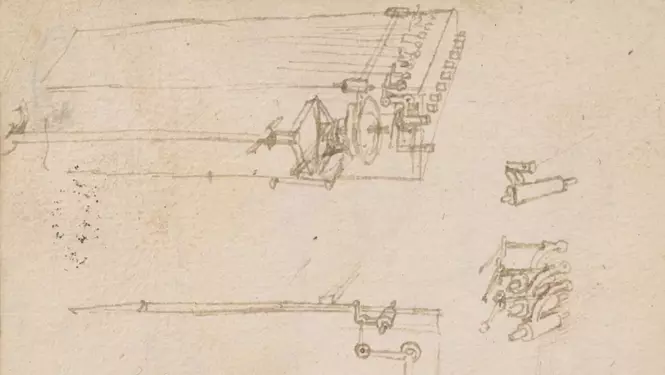
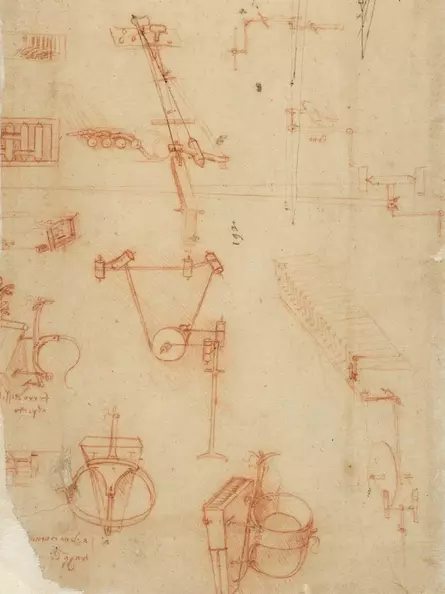
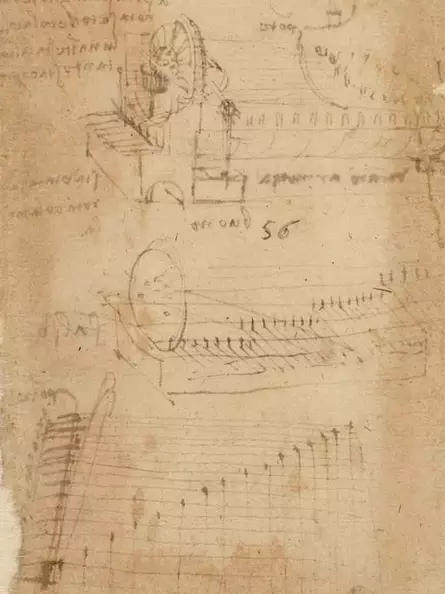
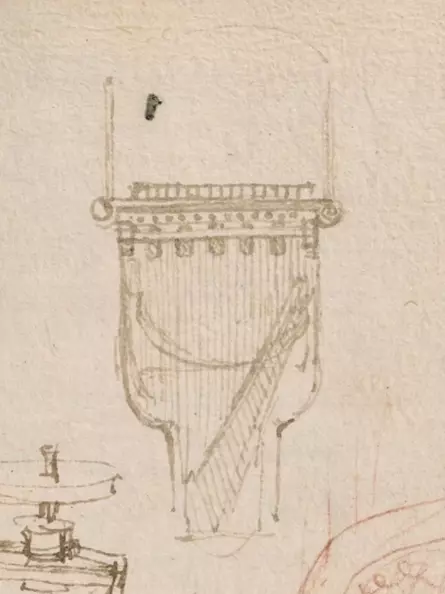
Entertainer
For the festivities, Leonardo prepared enigmatic questions that he presented for the entertainment of the guests. They were to be delivered as if they were obscure prophecies ("Say it quickly or as if you were mad") and were meant to provide general amusement when solved. Here are two examples:
"(Say it quickly or as if you were mad) Many will be occupied taking something away from it, which grows all the more the more is taken away." – A hole.
"The water of the sea will rise above the mountain peaks and fall from the sky onto the houses of men." – Clouds and rain.
Vasari writes in his biography of Leonardo that Leonardo made a dough from wax, and when it was in a liquid state, he shaped very delicate animals, which he filled with air. When he blew into them, they would fly. When the air was let out, they would fall back to the ground.
Vasari also writes that Leonardo supposedly tamed a lizard, to which he added wings made from the skin of other lizards that he had filled with mercury. When the lizard moved, its wings would tremble. Because he had also given it eyes, a beard, and horns, the creature now looked like a curious mythical being. Similar accounts mention squirrels that he captured, dressed in garments, and then released during a festival to the delight of the attending guests.
Given Leonardo's well-known love for animals, as confirmed by the vegetarian Leonardo himself in his notebooks, it is unclear to what extent these reports are true or whether they belong to the numerous legends that have been spread about Leonardo's life.
Sources
Frank Zöllner, Leonardo, Taschen (2019)
Martin Kemp, Leonardo, C.H. Beck (2008)
Charles Niccholl, Leonardo da Vinci: Die Biographie, Fischer (2019)
Frank Zöllner/ Johannes Nathan, Leonardo da Vinci - Sämtliche Zeichnungen, Taschen (2019)
Especially recommended
Marianne Schneider, Das große Leonardo Buch – Sein Leben und Werk in Zeugnissen, Selbstzeugnissen und Dokumenten, Schirmer/ Mosel (2019)